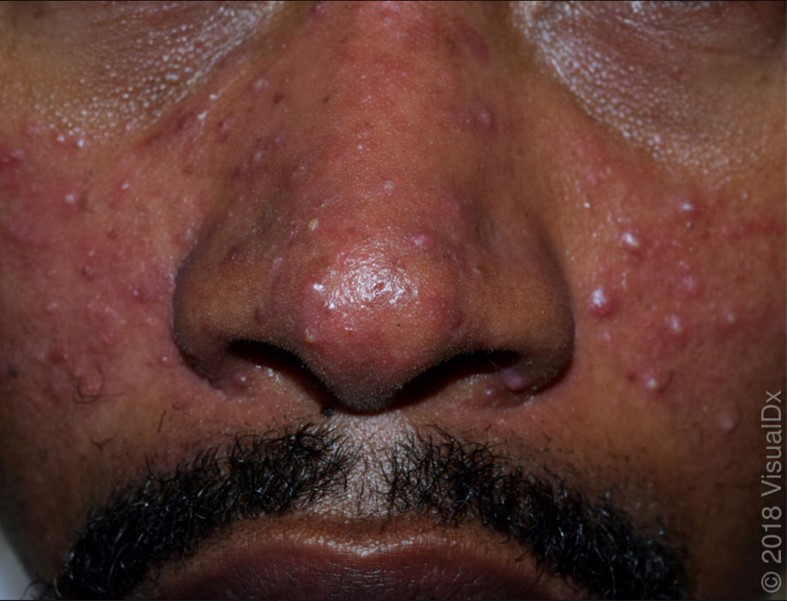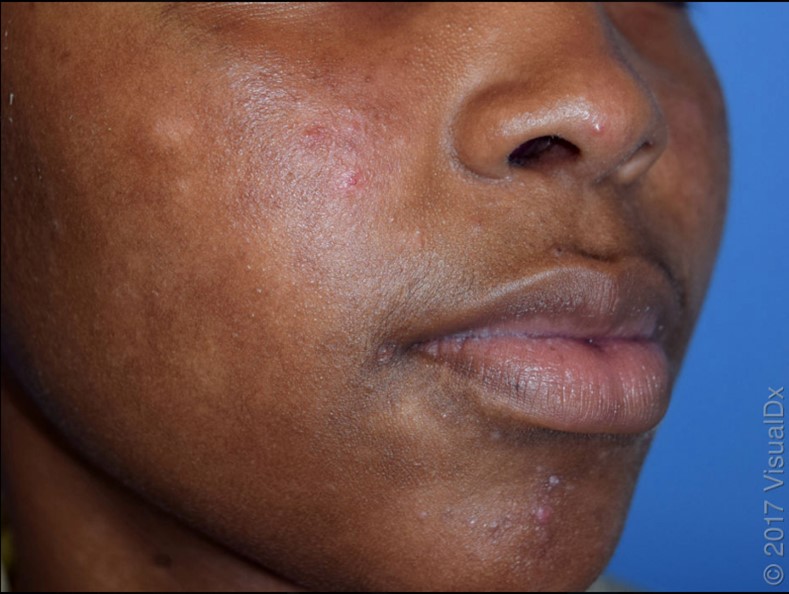Rosacea
Lisa Akintilo, MD/MPH; Stavonnie Patterson, MD; Neelam Vashi, MD

Image from VisualDx.
What is rosacea?
Rosacea is a chronic inflammatory condition that presents as facial flushing and facial redness. There are four main types of rosacea: erythematotelangiectatic, papulopustular, phymatous, and ocular. Clinical signs of rosacea include erythema (redness), telangiectasias (prominent blood vessels), papules (flesh-colored bumps), pustules (pus bumps or pimples), an irregularly enlarged nose/chin/forehead/ears/eyelids with prominent pores, or red irritated eyes. Patients with skin of color may not present with some of the more typical findings of rosacea. Some clues to the diagnosis in individuals with skin of color include a persistently warm or tight feeling on the central face, red or violet discoloration of the central face, acne-like breakouts that won’t go away with traditional acne treatments, facial itching, burning or stinging when applying facial products, or itchy irritated eyes. These symptoms may get worse with particular activities such as alcohol, sunlight, wind, heat, spicy foods, hot beverages, stress, or exercise.
What causes rosacea?
The cause of rosacea is unknown and probably due to a number of factors. It is thought that ultraviolet light (such as light from the sun), microbial exposure (particularly to Demodex mites), and microscopic changes to blood vessels in the face can all contribute.

Image from VisualDx.
How can rosacea be treated?
A common method for treating mild rosacea is through lifestyle modifications to avoid or minimize exposure to triggers such as hot temperatures, alcohol, hot beverages, spicy food, and stress. Avoidance of topical steroids is also encouraged. Camouflage with green- or yellow-tinted makeup can be helpful for some patients.
Topical medical therapies for rosacea include metronidazole, azelaic acid, brimonidine, ivermectin, sodium sulfacetamide and permethrin. Oral medical therapies include antibiotics like tetracyclines or azithromycin, or occasionally isotretinoin (previously known as Accutane) for severe cases. Surgery or carefully administered lasers may also be helpful in select cases.
References
- Onalaja AA, Lester JC, Taylor SC. Establishing the diagnosis of rosacea in skin of color patients. Cutis. 2019 Jul;104(1):38-41. PMID: 31487335.
- Powell FC, Raghallaigh SN. Rosacea and related disorders. In: Bolognia JL, Jorizzo JL, Schaffer JV, eds. Dermatology. 3rd ed. Philadelphia: Elsevier Saunders; 2012:561-569.
- Sarkar R, Podder I, Jagadeesan S. Rosacea in skin of color: A comprehensive review. Indian J Dermatol Venereol Leprol. 2020 Nov-Dec;86(6):611-621. doi: 10.4103/ijdvl.IJDVL_769_19. PMID: 33109832.

Cutis Journal
Read published peer-reviewed articles written your by Skin of Color Society members

Did You Know
Skin of color patients comprise the majority in California, New Mexico and Texas…and soon will be the majority in Arizona, Nevada, Georgia, New York and Florida.
By 2042, more than 50% of the US population will have skin of color.




